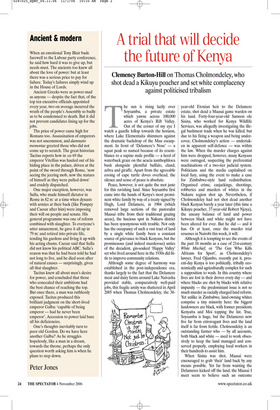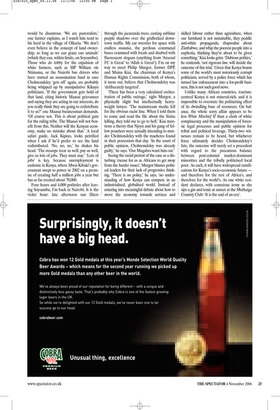A trial that will decide the future of Kenya
Clemency Burton-Hill on Thomas Cholmondeley, who shot dead a Kikuyu poacher and set white complacency against politicised tribalism The sun is rising lazily over Soysambu, a private estate which yawns across 100,000 acres of Kenya’s Rift Valley. Out of the corner of my eye I watch a gazelle lollop towards the horizon, where Lake Elementaita shimmers against the dramatic backdrop of the Mau escarpment. In front of ‘Delamere’s Nose’ — a squat peak so named because of its resemblance to a supine male profile — a herd of waterbuck graze on the acacia xanthophloea bush alongside plentiful buffalo, eland, zebra and giraffe. Apart from the agreeable cooing of cape turtle doves overhead, the silence and sense of peace is absolute.
Peace, however, is not quite the mot juste for this ravishing land. Since Soysambu first came into the hands of Kenya’s most prominent white family by way of a treaty signed by Hugh, Lord Delamere, in 1904 (which removed large sections of the pastoralist Maasai tribe from their traditional grazing areas), the luscious spot in Nakuru district has been synonymous with trouble. Not only has the occupancy of such a vast tract of land by a single white family been a constant source of grievance to black Kenyans, but the promiscuous (and indeed murderous) antics of the decadent, gin-soaked ‘Happy Valley’ set who lived around here in the 1930s did little to improve community relations.
Although some degree of harmony was established in the post-independence era, thanks largely to the fact that the Delamere meat and dairy farms around Lake Naivasha provided stable, comparatively well-paid jobs, this fragile amity was shattered in April 2005 when Thomas Cholmondeley, the 38 year-old Etonian heir to the Delamere estate, shot dead a Maasai game warden on his land. Forty-four-year-old Samson ole Sisina, who worked for Kenya Wildlife Services, was allegedly investigating the illegal bushmeat trade when he was killed, but due to his firing a weapon and being undercover, Cholmondeley’s action — undertaken in apparent self-defence — was within the law. When the murder charges against him were dropped, however, many Kenyans were outraged, suspecting the preferential machinations of a two-tier judicial system. Politicians and the media capitalised on local fury, using the event to make a case for Zimbabwe-style land redistribution. Organised crime, carjackings, shootings, robberies and murders of whites in the Nakuru region shot up. Nevertheless, if Cholmondeley had not shot dead another black Kenyan barely a year later (this time a Kikuyu poacher, 37-year-old Robert Njoya), the uneasy balance of land and power between black and white might not have been altered for ever. But he did — and it has. Or at least, once the murder trial resumes in Nairobi this week, it will.
Although it is tempting to see the events of the past 18 months as a case of 21st-century White Mischief, or ‘The Guy Who Kills Africans for Sport’, as Cholmondeley’s lawyer, Fred Ojiambo, recently put it, present-day Kenya is too politically, tribally economically and agriculturally complex for such a supposition to wash. In this country where lives are lost in their droves every day — and where blacks are shot by blacks with relative impunity — the predominant issue is not so much murder as racially charged land reform. Yet unlike in Zimbabwe, land-owning whites comprise a tiny minority here: the biggest landowners are black, with former presidents Kenyatta and Moi topping the list. True, Soysambu is huge, but the Delameres now live far from extravagant lives and the land itself is far from fertile. Cholmondeley is an outstanding farmer who — by all accounts, both black and white — used to work obsessively to keep the land managed and conserved properly, employing local workers in their hundreds to assist him.
When Sisina was shot, Maasai were encouraged to grab ‘their’ land back by any means possible. Yet far from wanting the Delameres kicked off the land, the Maasai I meet seem to believe such an outcome would be disastrous. ‘We are pastoralists,’ one farmer explains, as I watch him tend to his herd in the village of Olkaria. ‘We don’t even believe in the concept of land ownership, so long as we can graze our animals’ (which they can, within limits, on Soysambu). Those who do lobby for the expulsion of white farmers, such as MP William ole Ntimama, or the Nairobi bus drivers who have started an assassination fund in case Cholmondeley ‘gets off’ again, are probably being whipped up by manipulative Kikuyu politicians. ‘If the government gets hold of that land, citing historic Maasai grievances and saying they are acting in our interests, do you really think they are going to redistribute it to us?’ one Maasai businessman demands. ‘Of course not. This is about political gain for the ruling tribe. The Maasai will not benefit from this. Neither will the Kenyan economy, make no mistake about that.’ A local safari guide, Jack Kipino, looks petrified when I ask if he’d prefer to see the land redistributed. ‘No, no, no,’ he shakes his head. ‘The mzungu treat us well, pay us well, give us lots of jobs. They must stay.’ ‘Lots of jobs’ is key, because unemployment is endemic in Kenya, where Mwai Kibaki’s government swept to power in 2002 on a promise of creating half a million jobs a year but has so far created about 70,000.
Four hours and 4,000 potholes after leaving Soysambu, I’m back in Nairobi. It is the violet hour: late afternoon sun filters through the jacaranda trees, casting sublime purple shadows over the gridlocked downtown traffic. My car wrestles for space with endless mutatus, the perilous communal buses crammed with locals and daubed with fluorescent slogans (anything from ‘Arsenal FC is Great’ to ‘Allah is Great’). I’m on my way to meet Philip Murgor, former DPP, and Maina Kiai, the chairman of Kenya’s Human Rights Commission, both of whom, it turns out, believe that Cholmondeley was ‘deliberately targeted’.
‘There has been a very calculated orchestration of public outrage,’ sighs Murgor, a physically slight but intellectually heavyweight lawyer. ‘The mainstream media fell for the obvious racist line. When I told them to come and read the file about the Sisina killing, they told me to go to hell.’ Kiai mentions a theory that Njoya and his gang of fellow poachers were actually intending to murder Cholmondeley with the machetes found in their possession that day. ‘In the court of public opinion, Cholmondeley was already guilty,’ he says. ‘Our Mugabes want him out.’ Seeing the racial pretext of the case as a disturbing ‘excuse for us as Africans to get away from the harder issues’, Murgor blames political leaders for their lack of progressive thinking. ‘There is no policy,’ he says, ‘no understanding of how Kenya can compete in an industrialised, globalised world. Instead of entering into meaningful debate about how to move the economy towards services and skilled labour rather than agriculture, when our farmland is not sustainable, they peddle anti-white propaganda, rhapsodise about Zimbabwe, and whip the poorest people into a euphoria, thinking they’re about to be given something.’ Kiai looks grim. ‘Dubious politics,’ he contends, ‘not rigorous law, will decide the outcome of this trial.’ Given that Kenya boasts some of the world’s most notoriously corrupt politicians, served by a police force which has turned law enforcement into a for-profit business, this is not such good news.
Unlike many African countries, tourismcentred Kenya is not mineral-rich, and it is impossible to overstate the politicising effect of its dwindling base of resources. On balance, the whole sorry affair appears to be less White Mischief II than a clash of white complacency and the manipulation of forensic legal processes and public opinion for tribal and political leverage. Thirty-two witnesses remain to be heard, but whichever force ultimately decides Cholmondeley’s fate, the outcome will surely set a precedent with regard to the precarious balance between post-colonial market-dominant minorities and the tribally politicised local poor. As such, it will have widespread ramifications for Kenya’s socio-economic future and therefore for the rest of Africa’s, and therefore for the world’s. As one white resident declares, with conscious irony as she sips a gin and tonic at sunset at the Muthaiga Country Club: ‘It is the end of an era’.



















































































































 Previous page
Previous page